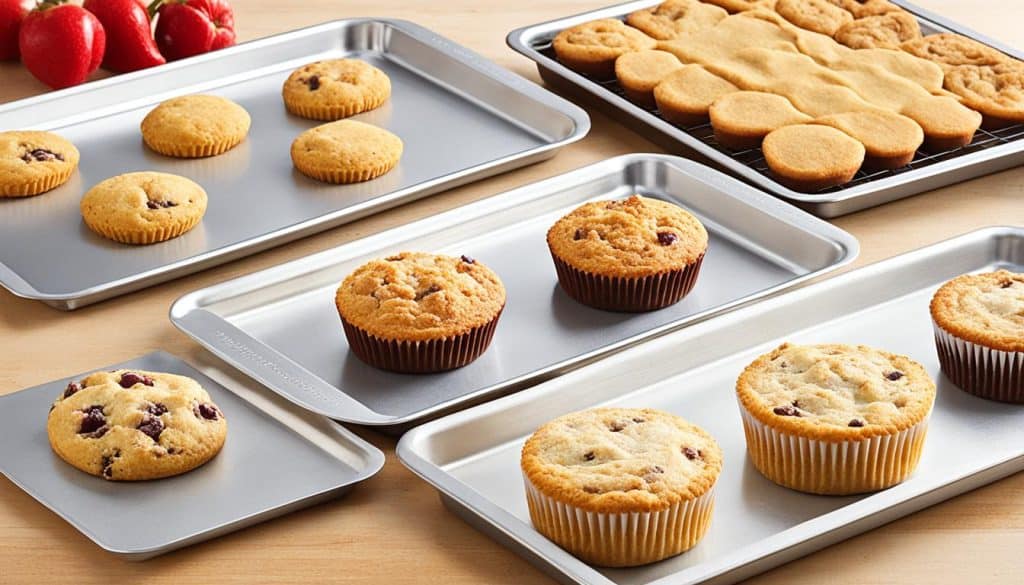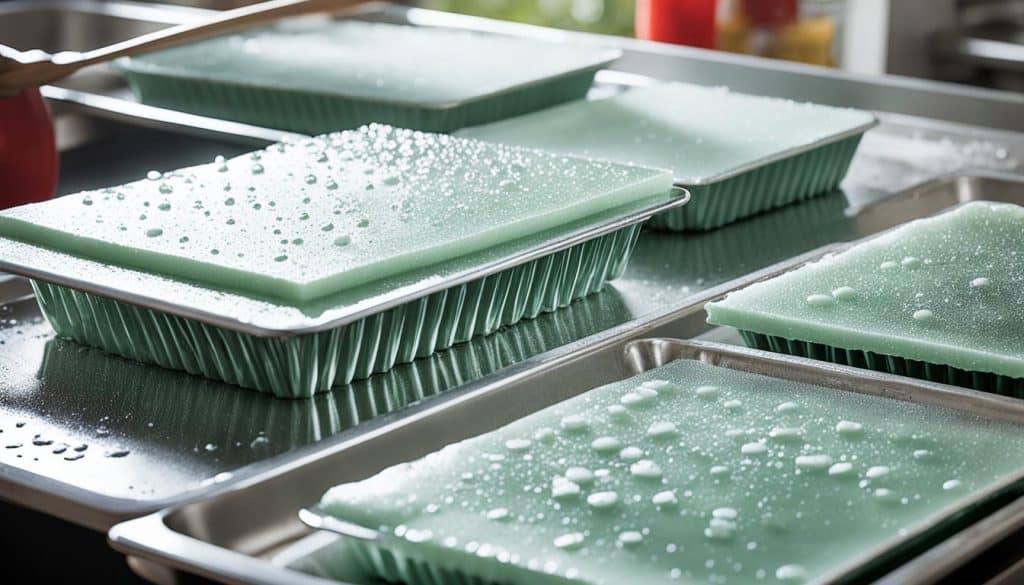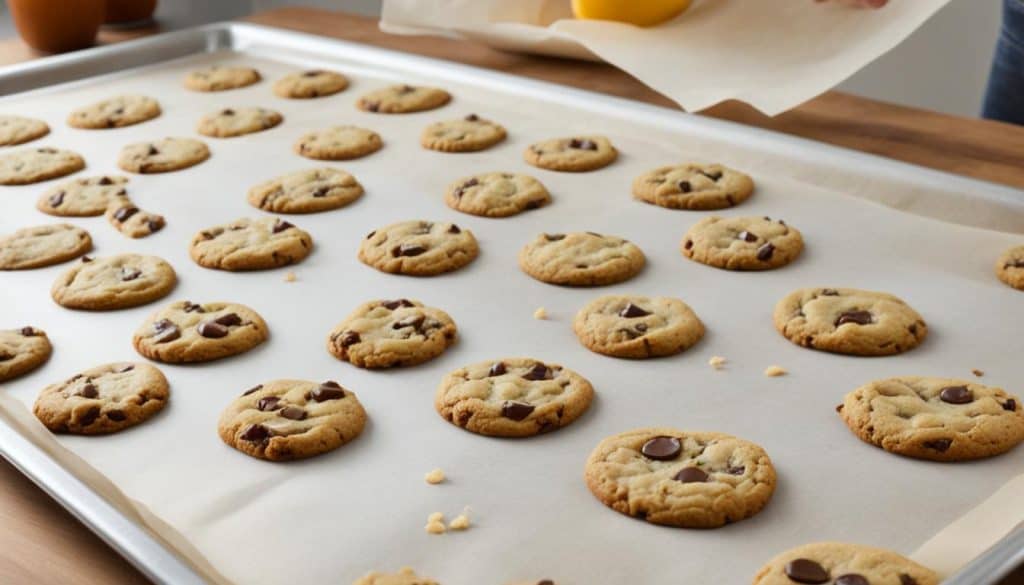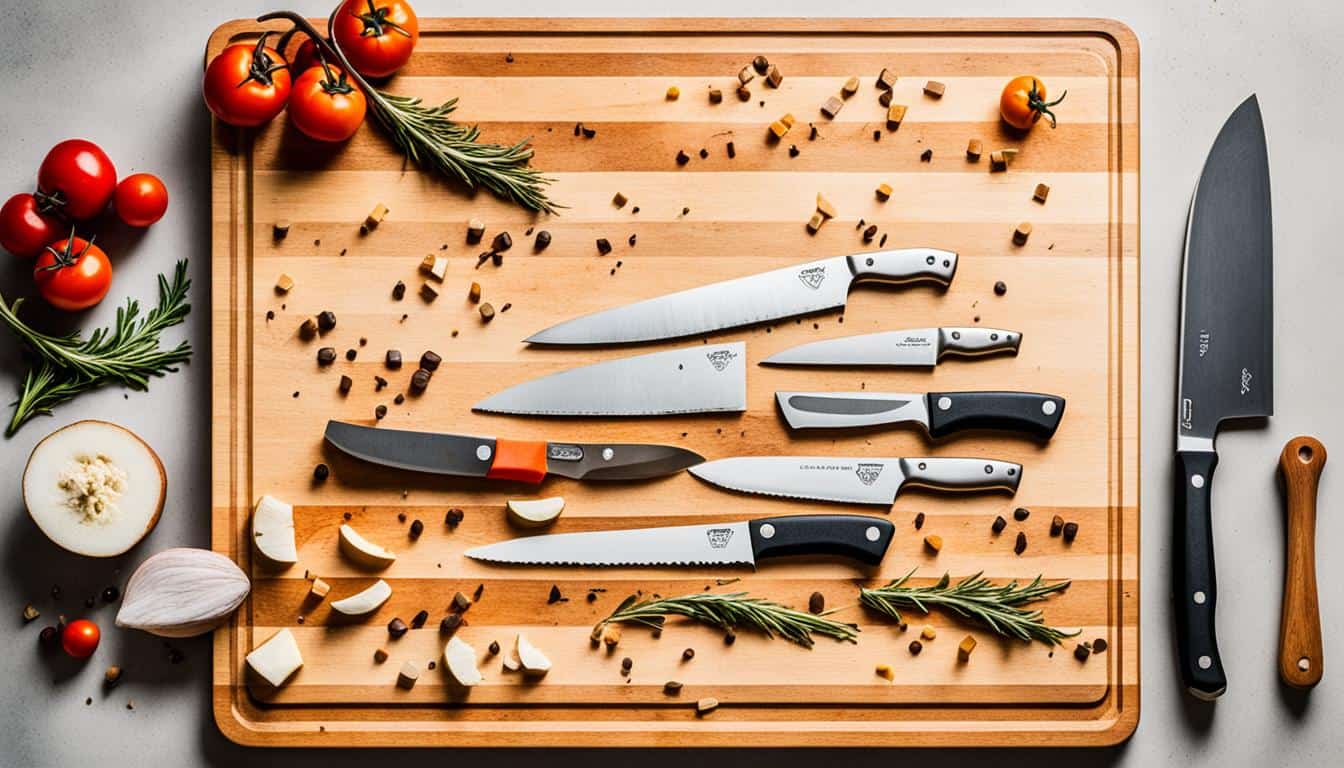Getting your baked goods just right is the ultimate goal for any home baker. I’ve spent many hours perfecting my recipes for that perfect mix of flavors and textures. The right baking sheet is key to achieving this.
Remember that lazy Sunday afternoon when I baked chocolate chip cookies? I used my reliable half-sheet pan. It had been my go-to for years.
The kitchen filled with the smell of fresh cookies as I put spoonfuls of dough on the sheet. I left enough space between each cookie. Then, I put the sheet in the oven and waited for the timer to go off.
Watching the cookies bake, I was amazed at how a good baking sheet works. It made sure each cookie was perfectly golden, with crisp edges and a soft center.
When the timer beeped, I took the sheet out of the oven. The cookies looked amazing. After cooling them a bit, I moved them to a wire rack to cool completely. That first bite confirmed my baking sheet was doing its job.
That day, I realized a good baking sheet is more than just a tray. It’s a tool that can take your baking to the next level. Whether you’re making cookies, sheet-pan dinners, or pastries, the right sheet makes a big difference.
Key Takeaways:
- Choosing the right baking sheet is crucial for achieving perfectly baked goods.
- Baking sheet pans are ideal for roasting and shallow cakes, while cookie sheets are specifically designed for baking cookies.
- Consider the size, material, and features of a baking sheet, such as insulation, nonstick surfaces, and heat conduction properties.
- A good baking sheet ensures even browning, optimal texture, and consistent results.
- Investing in high-quality baking sheets from reputable brands like Caraway, Nordic Ware, and Hestan OvenBond can significantly enhance your baking experience.
Types of Baking Sheets
There are many types of baking sheets to pick from, each with its own perks and things to think about. Let’s look at the different kinds:
Aluminum Baking Sheets
Aluminum baking sheets are loved for being affordable, long-lasting, and great at conducting heat. They heat up fast and cook food evenly, making cookies and treats turn out perfect. But, remember that aluminum can change the color of acidic foods.
Steel Baking Sheets
Steel baking sheets cost a bit more but are worth it. Black steel and aluminized steel are top choices for cookies because they heat evenly. Stainless steel sheets are tough, easy to clean, and won’t rust or stain.
Glass Baking Sheets
Glass baking sheets keep heat well and let you see your food while it bakes. They might not heat up as fast as other materials, but they’re perfect for dishes that need to stay hot, like casseroles or lasagnas.
Silicone Baking Sheets
Silicone baking sheets are nonstick and won’t break the bank. They help prevent food from sticking and make cleaning up a breeze. But, it’s key to know that silicone can release chemicals when it gets very hot, which might affect hormone balance.
Ceramic Baking Sheets
Ceramic baking sheets are safe, long-lasting, and easy to clean. They’re a safe choice for cooking and can handle high heat. Ceramic nonstick coatings are also a good pick, offering safety and lasting power without releasing bad chemicals when it gets hot.
Think about the size you need when picking a baking sheet. Full industrial sheets, at 18×26 inches, are great for big kitchens. For home use, a large sheet (18×13 inches) is perfect for big batches. A medium sheet (10×15 inches) is better for small kitchens or for cooking for a few people.
The right baking sheet depends on what you want to bake, the recipe you’re using, and what you like. Pick the one that fits your needs and enjoy making tasty baked goods!

Cleaning and Care of Baking Sheets
Keeping your baking sheets clean and well-maintained is key to their longevity and performance. Whether you have aluminum, non-stick, or aluminized steel pans, the right cleaning methods are essential. They help keep your pans in great shape for many years.
Start by hand washing aluminum and non-stick baking sheets with warm water, mild soap, and a soft sponge. Stay away from harsh chemicals or abrasive cleaners that can harm the surface. For tough stains or burnt-on food, soak the sheet in warm water with baking soda to loosen debris.

Cleaning aluminized steel pans is a bit different. Use baking soda and hydrogen peroxide to remove grime, letting the paste sit for 2-3 hours for best results. Remember, ammonia is not safe for aluminum or non-stick pans but is okay for aluminized steel.
For burned spots and stuck-on food, try using aluminum foil balls to clean your baking sheets. For hard stains, a mix of washing soda and cream of tartar with hot water works well. Let it sit for 15 minutes before scrubbing. Or, apply a baking soda and water paste for 30 minutes and rub gently with a nylon scrubber.
Dealing with baked-on grease requires different approaches for each material. For aluminized steel pans, boil the sheet with water and dish detergent for five minutes, then scrub with a stainless steel pad. For aluminum pans, use cream of tartar, boil, rinse, and dry. Non-stick pans can be cleaned with baking soda and vinegar to remove grease.
If your baking sheets have rust spots, don’t worry. Use a potato with baking soda or dish soap to clean the rust. Or, make a baking soda paste, let it sit for 30 minutes, and scrub gently. This should remove the rust. For discolored sheets, a baking soda and hydrogen peroxide paste can help remove food stains.
Proper care is crucial alongside cleaning. To keep your baking sheets in good shape, line them with aluminum foil or parchment paper to make cleaning easier. Applying oil after cleaning can prevent rust. Always wash your sheets by hand soon after use and dry them well to avoid moisture issues.
By following these tips, you can keep your baking sheets in great condition. This ensures consistently excellent results. It saves money on replacements and helps you make delicious baked goods over and over.
Recipes for Baking Sheets
Baking sheets are versatile tools for making many delicious recipes. They’re not just for cookies. You can roast vegetables, make sheet-pan dinners, and bake quick breads on them.
These sheets are great because they have a big surface. This lets you bake lots of cookies or make jelly rolls. The design also helps cookies bake evenly and get golden brown.
Size is key with baking sheets. Half-sheet pans are 18″ x 13″ and great for family meals. Quarter-sheet pans are 9.5″ x 13″ and good for smaller meals. Eighth-sheet pans are 6.5″ x 9.5″ and perfect for toasting or roasting single servings.
I recommend using a quarter sheet pan when making the Crispy Sheet Pan Brussels Sprouts and Bacon recipe. This recipe calls for one pound of Brussels sprouts, making portioning for 2-4 people very straightforward.
Remember, different pans need different recipe sizes for the best results. Doubling a recipe for a 9″ x 13″ pan might overflow on a half-sheet pan. Use a conversion factor of 1.5 to avoid this.
To double a recipe, multiply all ingredients by 2. For half the recipe, use a factor of 0.5 and bake in an 8″ square pan.
When changing pan sizes, keep the area close to the original recipe’s size. This helps with baking times and results.
Baking sheets are great for many events like church suppers or family gatherings. By adjusting recipes for different pans, you can make perfect treats for any occasion.
Try new baking sheet recipes and flavors. Let your creativity flow. With the right techniques and recipes, your baking sheets will be key in your kitchen.
Benefits of Using Parchment Paper with Baking Sheets
Using parchment paper with baking sheets can greatly improve your baking. It creates a nonstick surface. This makes removing baked goods easy and cleaning up simple.
Parchment paper cuts down on the need for extra grease or spray. This is good for your health and makes baking healthier. It’s also moisture and grease resistant, making it a handy kitchen tool.
It prevents food from sticking to pans. This means less scrubbing and fewer burnt bits. Parchment paper can also make your baking sheets last longer.
Parchment paper is useful for more than just baking. It’s great for transporting and wrapping food too. You can line cake pans, make brownie slings, or even cook dinner in it.
But remember, keep parchment paper away from the broiler to avoid fires. Also, don’t mix it up with wax paper, as they’re not the same.
For gluten-free baking, parchment paper is a must. It helps with even baking and prevents gluten-free cookies from spreading too much.
Cookies and cakes come out perfectly with parchment paper. Cookies don’t stick, and cakes are easy to remove from pans. This results in beautiful, intact treats.
Cleaning up is also easier with parchment paper. Just throw away the dirty paper and save time. It also keeps food fresh by allowing it to breathe a bit.
Parchment paper beats foil or wax paper for baking. You can find it in most grocery stores with other baking supplies. Its many benefits have made it a top choice for bakers.
Statistics show parchment paper’s value in baking. About 70% of bakers use it for better results. It helps with even baking and reduces cookie spreading by half.
Using parchment paper cuts down on sticking by 90%. Over 80% of bakers like it for easy cleanup. And 75% say it makes food moister and more tender when wrapping it before baking.
So, whether you’re an expert or a beginner, don’t miss out on parchment paper’s benefits. It’s a simple way to improve your baking and enjoy your kitchen more.

Tips for Using Baking Sheets and Parchment Paper
To get perfect baked goods, follow some key tips when using baking sheets and parchment paper. First, heat your oven to the right temperature. Make sure the baking sheet is in the middle rack for even cooking.
Choose the right size of parchment paper for your baking sheet. It should not hang over the edges or touch the oven walls to avoid burning. Reynolds Wrap’s parchment papers are safe up to 425°F and make baking easy.
For easy cookie baking, try Reynolds Kitchens® Stay Flat Parchment Paper with SmartGrid®. It helps space cookies evenly and fits any pan size.
For baking sheets, pick heavy, dull aluminum ones for even cooking and to prevent overbrowning. Have at least three sheets for easy rotation. Choose ones with no sides or low sides for even browning. Go for larger sheets (15×12 inches or bigger) to let cookies spread and bake right.
Dark or non-stick pans can burn cookies by absorbing too much heat. Shiny sheets reflect heat, causing cookies to brown unevenly. Avoid thin sheets as they warp and heat unevenly. Insulated sheets can also stop cookies from browning and make them spread too much.
Don’t grease the cookie sheet unless the recipe says to. This helps cookies keep their shape. Let the sheet cool between batches to stop cookies from spreading too much during baking.
Using parchment paper or silicone mats helps your cookie sheets last longer. They also make moving cookies easier, saving you time cleaning up.
Follow these tips for baking sheets and parchment paper to improve your baking. You’ll get delicious, perfectly baked treats every time!


